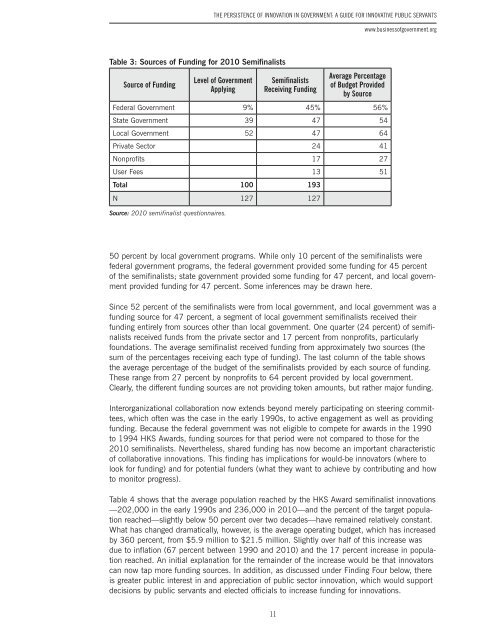The Persistence of Innovation in Government
The Persistence of Innovation in Government
The Persistence of Innovation in Government
- No tags were found...
You also want an ePaper? Increase the reach of your titles
YUMPU automatically turns print PDFs into web optimized ePapers that Google loves.
<strong>The</strong> <strong>Persistence</strong> <strong>of</strong> <strong>Innovation</strong> <strong>in</strong> <strong>Government</strong>: A Guide for Innovative Public Servantswww.bus<strong>in</strong>ess<strong>of</strong>government.orgTable 3: Sources <strong>of</strong> Fund<strong>in</strong>g for 2010 Semif<strong>in</strong>alistsSource <strong>of</strong> Fund<strong>in</strong>gLevel <strong>of</strong> <strong>Government</strong>Apply<strong>in</strong>gSemif<strong>in</strong>alistsReceiv<strong>in</strong>g Fund<strong>in</strong>gAverage Percentage<strong>of</strong> Budget Providedby SourceFederal <strong>Government</strong> 9% 45% 56%State <strong>Government</strong> 39 47 54Local <strong>Government</strong> 52 47 64Private Sector 24 41Nonpr<strong>of</strong>its 17 27User Fees 13 51Total 100 193N 127 127Source: 2010 semif<strong>in</strong>alist questionnaires.50 percent by local government programs. While only 10 percent <strong>of</strong> the semif<strong>in</strong>alists werefederal government programs, the federal government provided some fund<strong>in</strong>g for 45 percent<strong>of</strong> the semif<strong>in</strong>alists; state government provided some fund<strong>in</strong>g for 47 percent, and local governmentprovided fund<strong>in</strong>g for 47 percent. Some <strong>in</strong>ferences may be drawn here.S<strong>in</strong>ce 52 percent <strong>of</strong> the semif<strong>in</strong>alists were from local government, and local government was afund<strong>in</strong>g source for 47 percent, a segment <strong>of</strong> local government semif<strong>in</strong>alists received theirfund<strong>in</strong>g entirely from sources other than local government. One quarter (24 percent) <strong>of</strong> semif<strong>in</strong>alistsreceived funds from the private sector and 17 percent from nonpr<strong>of</strong>its, particularlyfoundations. <strong>The</strong> average semif<strong>in</strong>alist received fund<strong>in</strong>g from approximately two sources (thesum <strong>of</strong> the percentages receiv<strong>in</strong>g each type <strong>of</strong> fund<strong>in</strong>g). <strong>The</strong> last column <strong>of</strong> the table showsthe average percentage <strong>of</strong> the budget <strong>of</strong> the semif<strong>in</strong>alists provided by each source <strong>of</strong> fund<strong>in</strong>g.<strong>The</strong>se range from 27 percent by nonpr<strong>of</strong>its to 64 percent provided by local government.Clearly, the different fund<strong>in</strong>g sources are not provid<strong>in</strong>g token amounts, but rather major fund<strong>in</strong>g.Interorganizational collaboration now extends beyond merely participat<strong>in</strong>g on steer<strong>in</strong>g committees,which <strong>of</strong>ten was the case <strong>in</strong> the early 1990s, to active engagement as well as provid<strong>in</strong>gfund<strong>in</strong>g. Because the federal government was not eligible to compete for awards <strong>in</strong> the 1990to 1994 HKS Awards, fund<strong>in</strong>g sources for that period were not compared to those for the2010 semif<strong>in</strong>alists. Nevertheless, shared fund<strong>in</strong>g has now become an important characteristic<strong>of</strong> collaborative <strong>in</strong>novations. This f<strong>in</strong>d<strong>in</strong>g has implications for would-be <strong>in</strong>novators (where tolook for fund<strong>in</strong>g) and for potential funders (what they want to achieve by contribut<strong>in</strong>g and howto monitor progress).Table 4 shows that the average population reached by the HKS Award semif<strong>in</strong>alist <strong>in</strong>novations—202,000 <strong>in</strong> the early 1990s and 236,000 <strong>in</strong> 2010—and the percent <strong>of</strong> the target populationreached—slightly below 50 percent over two decades—have rema<strong>in</strong>ed relatively constant.What has changed dramatically, however, is the average operat<strong>in</strong>g budget, which has <strong>in</strong>creasedby 360 percent, from $5.9 million to $21.5 million. Slightly over half <strong>of</strong> this <strong>in</strong>crease wasdue to <strong>in</strong>flation (67 percent between 1990 and 2010) and the 17 percent <strong>in</strong>crease <strong>in</strong> populationreached. An <strong>in</strong>itial explanation for the rema<strong>in</strong>der <strong>of</strong> the <strong>in</strong>crease would be that <strong>in</strong>novatorscan now tap more fund<strong>in</strong>g sources. In addition, as discussed under F<strong>in</strong>d<strong>in</strong>g Four below, thereis greater public <strong>in</strong>terest <strong>in</strong> and appreciation <strong>of</strong> public sector <strong>in</strong>novation, which would supportdecisions by public servants and elected <strong>of</strong>ficials to <strong>in</strong>crease fund<strong>in</strong>g for <strong>in</strong>novations.11


